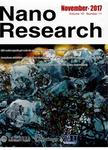Van der Waals interfacial bonding and intermixing in GeTe-Sb2Te3-based superlattices
Van der Waals interfacial bonding and intermixing in GeTe-Sb2Te3-based superlattices作者机构:Leibniz Institute of Surface Modification (IOM) Permoserstr. 15 Leipzig D-04318 Germany
出 版 物:《Nano Research》 (纳米研究(英文版))
年 卷 期:2018年第11卷第3期
页 面:1676-1686页
核心收录:
学科分类:1305[艺术学-设计学(可授艺术学、工学学位)] 13[艺术学] 08[工学] 080502[工学-材料学] 0805[工学-材料科学与工程(可授工学、理学学位)]
基 金:support of the European Union and the Free State of Saxony (LenA project)
主 题:interfacial phase change memory (iPCM) thin films intermixing Cs-corrected scanningtransmission electron microscopy
摘 要:Interfacial phase change memory (iPCM) based on GeTe and Sb2Te3 superlattices (SLs) is an emerging contender for non-volatile data storage applications. A detailed knowledge of the atomic structure of these materials is crucial for further development of SLs and for a better understanding of the resistivity switching characteristics of iPCM devices. In this work, crystalline GeTe-Sb2TeB- based SLs, produced by pulsed laser deposition onto a Si(111) substrate at temperatures lower than in previous studies, are analyzed by advanced scanning transmission electron microscopy. The results reveal the formation of Ge-rich Ge(x+y)Sb(2-y)Tez building blocks with specific numbers of ordered Ge cation layers (between I and 5) and disordered cation layers (4) for z = 6-10, as well as intermixed cation layers for z = 5, within the SLs. The G Ge(x+y)Sb(2-y)Tez units are separated from the Sb2Te3 building blocks by van der Waals gaps. In particular, the interlayer bonding is promoted by the formation of outermost cation layers consisting of intermixed GeSb within the building blocks adjacent to the van der Waals gaps. The Ge(x+y)Sb(2-y)Tez units with z 〉 5 retain metastable crystal structures with two-dimensional bonding within the SLs. The present study shed new light on the possible configurations of the building units that can be formed during the synthesis of GeTe-Sb2Te3-based iPCM materials. In addition, a possible switching mechanism active in iPCM materials is discussed.



